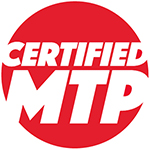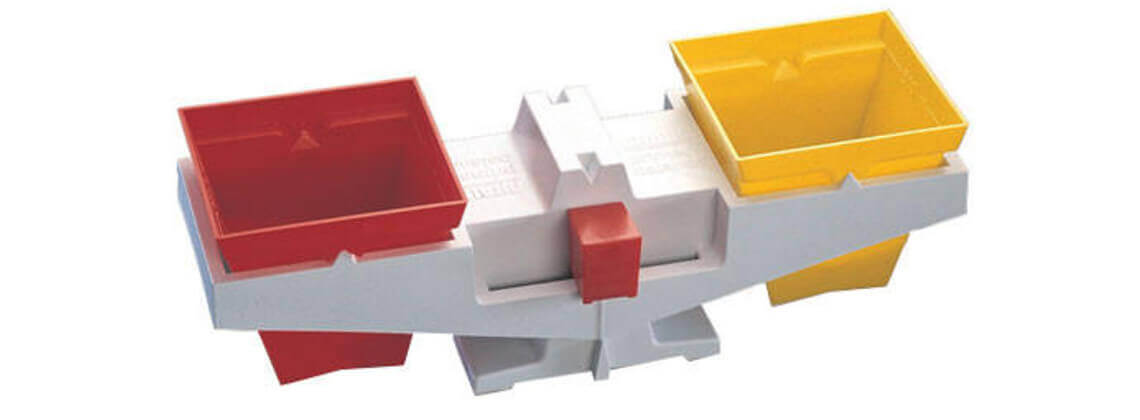Did you know? If a scientist weighed two identical objects on Earth and the Moon, a three-beam scale would provide the same mass reading in both instances, despite the Moon having one-sixth of Earth’s gravity. In contrast, if you weighed an identical sample on the Moon using a digital scale, the recorded weight would be lower on the Moon than on Earth. How does this happen? The answer lies in the unit of measurement. While a digital scale measures weight, a three-beam scale accurately measures mass. This gives the three-beam scale unique properties, making it an excellent tool for scientists, researchers, and students alike. But let’s get back to basics. How does a three-beam scale work, and how do you use a three-beam scale? In this article, we’ll answer these questions and explain where you can find the best three-beam scales for all your testing applications.
How to use a triple beam balance?
It is an essential laboratory tool used to accurately measure the mass of objects, liquids, and substances.
It differs from other scales because it measures mass, not weight. Unlike spring scales and digital scales, the triple beam balance doesn’t rely on gravitational force to produce an accurate measurement.
While digital and spring scales are excellent for their versatility, portability, and ease of use, the triple beam balance suits those who want an accurate, reliable reading for experiments that require precise results.
Most triple beam balances come with three parallel beams, hence the name. Each beam comes with a sliding weight that a tester can move from one side of the beam to the other. The central beam increases in divisions of 100g. The upper beam in divisions of 10g, and the lower beam in divisions of 0.1g.
Testers can use the triple beam balance to measure the weight of a sample to the nearest 0.05 grams. This makes them excellent for various scientific, industrial, and construction applications.
This is also fast, reliable, and easy to use, making it a popular choice in classroom settings.
Some specialized it, like the Dial-O-Gram balance, come with two beams and a dial, allowing the user to precisely control the balance weight by rotating a special dial.
This allows for accurate fine-tuning and improves the readability of the final mass, reducing the chance of human error.
Keep Reading: Balance vs Scale: Which One to Use and When?
Understanding the components of a triple beam balance
Learning how to use a triple beam balance consists of several simplistic individual components that work in tandem to achieve
- The Weighing Pan: The weighing pan is a flat surface where the tester places the item they want to weigh. Most weighing pans are easily removable, allowing for easy cleaning following tests.
- Beams: It have three parallel beams extending across the base. The beams are graduated with increments that help the tester measure a sample’s mass to the nearest 0.1g.
- Weight poise: It features three weight poises (also known as riders or counter masses) that slide along the beams to accurately measure the sample. Before measuring an object’s mass, the tester positions each weight poise at zero (to the far left side of the beams).
- Scales: The scales are located at the far right of the triple beam balance. They are marked with a ‘0’. Before weighing a sample, the balance pointer should be adjusted to align with the zero position using the adjustment knob.
- Adjustment knob: The triple beam balance features an adjustment knob positioned at the left of the pan. Turning the knob adjusts the resting position of the beams, allowing the tester to line up the pointer to the fixed mark on the scales.
- Attachment weights: Some triple beam balances come with additional weights designed to attach to the beams. These allow the tester to weigh samples with a greater mass than it could usually measure.
How does a triple beam balance work?
It is simple to use but delivers remarkably accurate results when one learns how to use a triple beam balance.
During a triple beam balance test, the tester places the object to be weighed on a weighing pan, and then slides the three weight points along the beams until the sample and scale reach an equilibrium.
Once the object’s mass is equal to the force applied by the sliding weights, the tester can measure the results to find the mass of the sample to the nearest 0.5g.
To make this concept clearer, let’s look at an analogy.
More Read: Triple Beam Balance: A Must-Have Precision Tool for Science.
The seesaw analogy
In fundamental terms, the triple beam balance works much like a seesaw.
Imagine two riders positioned on a seesaw graduated with measurement lines.
The first rider, whose mass is unknown and needs measurement, positions themselves at the far left of the seesaw. The second, heavier rider, whose mass is known, acts as the weight poise at the center.
At this stage, the seesaw tilts toward the left side, shifting the balance to the first rider. As the second rider slowly shifts their mass toward the right side, adding mass to it, the weight balance gradually shifts.
Eventually, the second, heavier rider causes the seesaw to level. Once the seesaw achieves complete parallelism and both riders reach an equal height, you can calculate the mass of the first rider by measuring the distance the second rider has moved along the seesaw.
310g vs. 610g vs. 2610g triple beam balances: What’s the difference in how to use a triple beam balance
When searching for three-beam scales, you may come across three common types: 310g three-beam scales, 610g three-beam scales, and 2610g three-beam scales. All variants look almost identical, but what’s the difference?
In short, the amount of grams specified on a three-beam scale refers to the maximum mass it can accurately weigh. Any mass greater than the maximum amount of grams weighable on your three-beam scale will cause the weighing pan to lower permanently until you remove the object.
610g triple beam balance
Most triple beam balances measure up to 610g by default. The central beam increases in increments of 100g and measures a total mass of 500g. The top beam measures up to 100g and is graduated in increments of 10g. The lowest beam is the key to precise measurements. It weighs up to a total of 10g and is graduated in 0.1g increments.
2610g triple beam balance
Many triple beam balances also come with additional balance weights. The three weights typically have a mass of 1000g, 1000g, and 500g. Two weights can attach to the balance beam simultaneously, meaning the tester can accurately weigh a total mass of 2610g.
310g triple beam balance
Some precise triple beam balances, such as this Cent-O-Gram balance, weigh up to a mass of 310g. These specialized balances help weigh the exact mass of small samples.
Which triple balance beam should I choose?
Whether you choose a 310g, 610g, or 2610g It will depend entirely on the application for which you intend to use the scale.
Small-scale experiments, such as those conducted in the pharmaceutical industry or an educational setting, suit 310g and 610g triple beam balances. The 310g balance beam is also helpful for determining the specific gravity of soils.
For large-scale experiments in research laboratories or industrial settings, a 2610g scale is the ideal choice.
How to use a triple beam balance: step by step
Using a triple beam balance is quick and easy. Follow these simple steps to get started.
This guide will assume that you are using a 610g triple beam balance, though you can easily adapt the methodology for 310g or 2610g equipment and learn how to use a triple beam balance
Methodology for how to use a triple beam balance
- Set up: Place the triple beam balance on a level, stable surface free from vibrations or potential disturbances.
- Eliminate inconsistencies: Check that the pan is free of water, debris, or particles from previous tests, as this could distort the final reading and make it challenging to find a precise measurement.
- Prepare the weight poises: Ensure that each sliding weight poise is set to zero. You can accomplish this by moving each weight poise along the three beams as close to the weighing pan as possible.
- Zero the scales: Use the zero adjustment knob to move the pointer until it precisely lines up with the zero point on your scales. This calibrates the scales and ensures your measurements will be accurate.
- Tare containers (optional): If weighing a liquid or material using a container, tare the container first by placing it on the weighing pan and calibrating the pointer back to the zero mark.
- Prepare your sample: Make sure the object you are weighing is clean and dry, then place it on the weighing pan.
- Adjust the center beam: Move the weight poise on the center beam to the right, one notch at a time, until the pointer drops below the zero line. When this happens, move the weight poise back one notch to return the pointer back to its raised position. For example, if your sample weighs 352g, the pointer will fall below 0 once you move the weight poise to 400g. At this point, you should move the rider back to 300g.
- Adjust the upper beam: Move the weight poise on the upper beam to the right, one notch at a time. When the pointer drops below the zero line, move the weight poise back one increment until it returns to its position above the zero mark. For the same 352g sample, the pointer would fall below 0 when the weight poise reaches the 60g notch. At this point, you should move the slider back to 50g.
- Adjust the lower beam: Gently slide the lower beam weight poise, moving it slowly along the beam until the pointer begins to lower. Fine-tune the slider’s position until the pointer lines up precisely with the zero mark. Adjust as necessary until the triple beam is perfectly balanced. For the 352g sample, the pointer would fall below 0 when the weight poise reaches the 2g notch. You can then move the slider in 0.1g increments until the pointer and zero mark reach equilibrium.
- Record the measurement: To find the exact mass of the sample, add all three measurements together. For example: 300g + 50g + 2g = 352g. This is the true mass of the sample.
Bonus tip:
If the pointer still doesn’t fall below zero with all three weights positioned to the right, the object’s mass is too high to measure. In this case, consider using attachment weights to increase the base weight of the scale before measuring again. This is how to use triple beam balance.
Where can I find out how to use a triple beam balance?
Certified MTP knows How to use a triple beam balance, and offers a range of high-quality triple balance beams from top brands across the US. To find out more, browse our full list of Ohaus balance beams and Adam Equipment balance beams.
Looking for something else? We also offer a wide range of spring scales, washdown scales, jewelry scales, and platform scales.
All of our products are built for efficiency and designed to give you accurate results every single time.
Can’t find what you’re looking for? Get in touch. Our team of experts is on hand to help you find the equipment that meets your needs.

